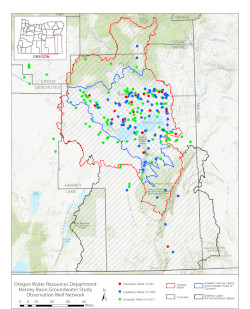Overview
In 2015, initial groundwater level data analysis and aquifer recharge estimates indicated annual groundwater use and other discharge likely exceeded annual groundwater recharge in the Harney Basin, which is the northern portion of the Malheur Lake Administrative Basin. As a result, the Department determined that additional groundwater uses had the potential to harm existing water users or allocate water beyond the capacity of the resource. The Water Resources Commission updated the Malheur Lake Basin Program rules in April 2016 to designate the Greater Harney Valley as a groundwater area of concern. The updated rules provided a path forward for permits that had been pending when the rulemaking process was initiated and limited future allocations of groundwater by classifying the area for exempt uses only. The Department also began a multi-year groundwater basin study to improve understanding of the Harney Basin groundwater system and groundwater budget and inform future water management decisions in the Basin. The Department is currently working with the community and other interested stakeholders to determine future management actions to achieve reasonably stable groundwater levels.
Policy and Rulemaking
The Water Resources Commission adopts basin program rules to set policies for how water is managed in an Administrative Basin. The current Malheur Lake Basin Program rules (OAR-690-512)
can be found here.
Harney Basin Groundwater Study and Ongoing Monitoring
 The Department has been working on a groundwater basin study in cooperation with the US Geological Survey (USGS). An intensive data gathering effort occurred between 2015 and 2018, a data analysis and reporting stage began in 2019, and the peer-review and publication process occurred from 2020 to 2022.
A groundwater study advisory committee, which included local water users and other interested stakeholders, was jointly appointed by the Department and the County Court to receive updates and provide input into the study. The advisory committee had their final meeting in December 2019.
The Department has been working on a groundwater basin study in cooperation with the US Geological Survey (USGS). An intensive data gathering effort occurred between 2015 and 2018, a data analysis and reporting stage began in 2019, and the peer-review and publication process occurred from 2020 to 2022.
A groundwater study advisory committee, which included local water users and other interested stakeholders, was jointly appointed by the Department and the County Court to receive updates and provide input into the study. The advisory committee had their final meeting in December 2019.
In April of 2022, the USGS published two groundwater study reports; one report describes the water budget for the basin and the second report describes the groundwater flow system. The reports went through a tiered scientific peer review process in 2020 and 2021, including technical experts independent of the study.
The Department continues to measure groundwater levels in 109 wells on a quarterly basis throughout the Harney Basin. These monitoring efforts build on years of monitoring that was conducted to inform the groundwater study.
For more information on the groundwater study, including meeting materials from the groundwater study advisory committee meetings,
can be found here.
The USGS also maintains a web page with information related to the
Harney Basin groundwater study.
Planning, Projects, and Partnerships
In 2016 the Department issued a grant to the Harney County Watershed Council to support a place-based integrated water resources planning effort to achieve "a sustainably managed supply of quality water for people, the economy, and the environment." This is a locally led effort convened by the Watershed Council and County Court. The collaborative has completed the groundwater portion of the integrated plan and is currently focused on strategies and actions to reduce surface water use. The collaborative anticipates completing surface water planning in fall 2023 and finishing their integrated plan sometime in early 2024. The Department is a partner in this effort in addition to providing financial and technical assistance. More information about this effort, including opportunities to be involved can be found on the Harney County Watershed Council website.
The Department is also a partner in numerous efforts in the basin to inform and support water management activities. For instance, the Department worked with local and federal partners to secure two new Bureau of Reclamation Agrimet stations for the basin and is helping to develop satellite-based tools to help irrigators achieve more crop per drop and monitor basin-wide consumptive water use over time.
The Department will work to establish the Greater Harney Valley Well Fund (Fund) as directed by House Bill 3092 for the purpose of replacing, repairing or deepening domestic personal use wells that are affected by declining groundwater levels resulting from over-allocation of groundwater within the Greater Harney Valley Groundwater Area of Concern. The Statewide Water Well Abandonment, Repair, and Replacement Fund was authorized through the passage of HB 2145 to provide financial assistance to persons or members of a federally recognized Indian tribe in Oregon to permanently abandon, repair, or replace a water well used for household purposes is another option for homeowners in the Harney Basin as well.
The Harney Conservation Reserve Enhancement Program (CREP) is an agreement being developed between the USDA Farm Service Agency and the state. Once the agreement is executed, up to 20,000 acres of eligible groundwater irrigated lands could be enrolled in 14–15-year contracts for payment incentives in exchange for voluntary cancellation of groundwater rights, which will help reduce groundwater declines. This program will be launching in 2023, to learn more click here to read an informational CREP handout.